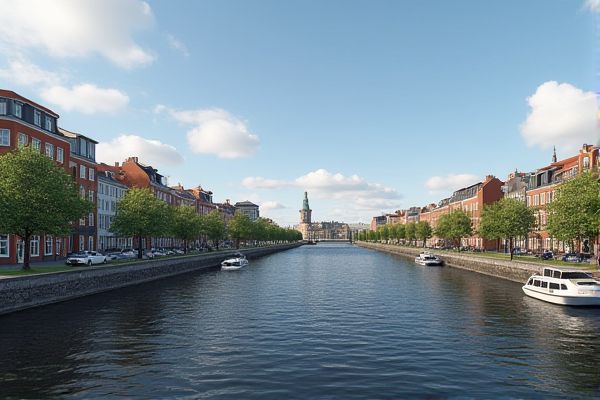
Utilities setup and providers in Denmark: Electricity provided by regional companies. Natural gas available in urban areas. District heating common in cities. Water services managed by local municipalities. Internet providers offer fiber and broadband options. TV licensing mandatory for device owners. Mobile networks include 4G and 5G coverage. Register with local energy provider upon move. Bill payment usually through automatic bank transfers. Contact providers early to avoid setup delays.
Electricity provided by regional companies.
In Denmark, the electricity sector is dominated by major companies such as Orsted A/S and Vattenfall, with the market structured through mergers and transactions since 2003. The country's electricity grid is divided into two systems, with the eastern part connected to the Nordic Grid and the western part to the Continental European grid, and is managed by Energinet.dk.
Natural gas available in urban areas.
In Denmark, Natural Gas is not predominantly used in urban areas, which are typically supplied by district heating. Instead, suburban areas with detached housing account for the biggest share of natural gas use for heating, with the transmission and distribution systems managed by Energinet and several distribution companies.
District heating common in cities.
In Denmark, District Heating is highly prevalent, with around 64% of private households connected to district heating systems, particularly in urban areas, where six large central district-heating areas and 400 smaller decentralized systems distribute heat, largely from combined heat and power plants and renewable sources. The nation's commitment to sustainable and efficient energy has made it a leader in this field, and more information about these efforts can be found on the [Danish Energy Agency](https://ens.dk/en/our-responsibilities/global-cooperation/experiences-district-heating) website.
Water services managed by local municipalities.
In Denmark, water services are managed primarily by local municipalities, with no single national ministry responsible for Water Supply and Sanitation. The Danish municipalities, along with five regional councils, oversee the planning, administration, and supervision of water suppliers and infrastructure, ensuring compliance with national laws and regulations. For more detailed information, you can visit the Wikipedia page dedicated to water supply and sanitation in Denmark.
Internet providers offer fiber and broadband options.
In Denmark, major Internet providers such as TDC NET, Norlys, and several local energy companies offer fiber and broadband options. Over 80% of Danish households have access to fiber Internet, with TDC NET upgrading its fiber network to provide symmetrical speeds above 1 Gb/s. Other providers like Waoo and FIBIA also play significant roles in the FTTH market, ensuring extensive coverage and high-speed connectivity across the country.
TV licensing mandatory for device owners.
In Denmark, the TV licence fee was abolished as of 2022, following a transitional period from January 1, 2019, to December 31, 2021, where the licence was gradually reduced and eventually replaced by funding through the Finance Act.
Mobile networks include 4G and 5G coverage.
In Denmark, mobile network coverage is extensive, with TDC having the most extensive overall coverage, including 99.9% 5G coverage nationwide. Other major operators like Telia, Telenor, and Hi3G (Three) also provide strong 4G and expanding 5G services, ensuring widespread mobile connectivity across the country. For more detailed information about the operators, you can visit the Mobile Operators page.
Register with local energy provider upon move.
To set up utilities in Denmark, you must enter an agreement with an electricity supplier, which you can choose freely. You can find and compare electricity suppliers using the Elpris.dk website, and your new supplier will handle the switch from your previous one.
Bill payment usually through automatic bank transfers.
In Denmark, utility bill payments, including electricity, are typically handled through automatic bank transfers. Consumers can set up direct debits using schemes like Betalingsservice for consumer-business transactions or Leverandorservice for business-to-business transactions, which rely on the Sum Clearing settlement system.
Contact providers early to avoid setup delays.
To ensure a seamless transition when moving homes, it is highly advisable to contact your electricity and gas suppliers well in advance. Ideally, you should reach out to them at least two months before your move to avoid any setup delays. The latest you should notify them is 10 working days before moving out and 14 working days after moving in. Providing essential information, such as your customer number, account number, and a final meter reading, will help streamline the process. For more details on setting up utilities when relocating, visit the Angloinfo website for comprehensive guidance tailored to your needs in Denmark.
